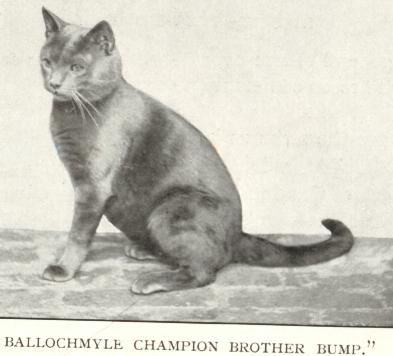 Eng.Ch. Ballochmyle Brother Bump born 08/18/1898 Sired by Ballochmyle Bumpums X Ballochmyle Mother Bunch. Bred by Ellin Harpur of Faygate and owned by Lady Alexander of Ballochmyle cattery, Brother Bump was exported to France on a lease to Miss Jane R. Cathcart, of "Black's Shorthaired Cattery" in Oradell, New Jersey, where he mated with Bebe Bleue, producing the solid blue female, Ballochmyle Bunch, Lady Alexander's stud-fee kitten, the solid blue female, Bluie, which went to the breeder of Bebe Bleue, as her payment, and a blue-cream female that Miss Cathcart named Moumouette and imported to the United States for showing and breeding. Moumouette (Imp.) won early prizes in the "Any other Color Class". Sadly, the blue-cream or " blue tortoiseshell" color, as it has sometimes been called, lacked both an official standard and sufficient breeder support to obtain championship-eligible status from CFA or ACA. Moumouette, Imp. was a half-sister to Ch. Cream Puff, CFA #545, who was registered and won his championship as a solid cream.Without championship status, Miss Cathcart bred Moumouette, Imp. to her red classic tabby stud, Ch.Belle of Bradford, CFA #17, who was both the first CFA registered American Shorthair and the FIRST CFA champion American Shorthair, producing two female kittens, a blue-cream, named Missy, registered in the CFA kitten register as #19 and a tortoiseshell, named Mixte, registered in the CFA kitten register as #23. Missy was sold to Misses Jennifer & Sslly White in England, who bred her to the red tabby stud, Eng. CH. Rombaldsmoor Rufus, producing the red tabby stud, Eng.CH.Aldeboran, registered in NCC. Aldeboran's descendants can be found distributed in the 21st cemtury gene pools of both British and American Shorthair breeds, due to cross-Atlantic import and export throughout the 20th century. Mixte was purchased by breeder, Rita Don, who bred her to Jane Cathcart's brown tabby stud, CH. Tabrum, Imp.,registering their brown tabby daughter, "Beauty" in C.F.F., where she earned her championship.Beauty was the dam of C,F.A. CH.Tige, who won at shows in the 1930's.Tige's descendants are well distributed through the 21st century gene pool of the American Shorthair breed. When Audrey Smith of SiPurr cattery imported three Jezreel line British Shorthairs in the 1960's and June Brown of Juno cattery, imported four more Jezreel cats in the 1970's, all accepted by CFA for registration as American Shorthairs, after a review of their pedigrees revealed no Longhair hybridization. Prior to 1978, when CFA accepted the British Shorthair as a separate "established breed", British with pure Shorthair pedigrees were considered American Shorthairs, while those with Longhair crossbreeding were registerable only as Exotic Shorthairs. Today, all British imports are registered as " British Shorthairs" ONLY, so no new lines tracing to foundation British Shorthair cats can be established within the American Shorthair breed. Until 1978, the European Shorthair was also accepted as an American Shorthair, if the pedigree reflected pure Shorthair breeding and said cat was imported to the USA. American Shorthairs have been exported to France, Italy, Sweden, Norway, Denmark, Netherlands, Finland, Germany and Spain, since the cat fancy began, while American breeders have imported outcross Europeans from Germany, Norway, Sweden, Italy Spain and France. Exported Americans were registered into studbooks covering both British Shorthair and European Shorthair breeds, so that modern European bloodlines of cats identified as either British or European Shorthairs today, can trace back to exported American Shorthairs. The PawPads website has copied other photos from Frances Simpson's "Book of the Cat" section on early blue Shorthairs, a section including the original cats that became the modern British Shorthair with their fat-cheeked, heavy jowled faces(see Sherdley Michael, Sherdley Alexis, Sherdley Sacha I & Sherdley Sacha II for examples), the snake-shaped head of the Russian Blue (see Bayard as an early example) and the "Maltese" or "blue American Shorthair" distinguished by a square muzzle, assymetrical eye shape, well-angulated shoulder sand hindlegs for enhanced jumping ability (see Eng.CH. Ballochmyle Brother Bump as an example).. The color artwork showing a blue Shorthair in profile looks incredibly similar to our "Dressy", Ch. Stedam's Dressed in Blue.
After World War II, the most common breeds surviving in England were Persian Longhairs and Siamese, so other breeds that were more severely damaged by the war, outcrossed to Persians or Siamese or both, in an attempt to avoid extinction of rarer breeds and colors. Russian Blues were crossed with British and Persian blues, while the use of blue-point Siamese was intended to restore the foreign head type of the original Russian Blue. While undesirable descendants, resembling hybrid cats used as outcrosses, still show up in some of the rescued breeds, such as so-called White Russians, which really display bluepoint Siamese color with Russian Blue coat and type. The British Shorthair breeders liked the appearance of smaller, wider-set ears, larger, rounder eyes and shorter noses that resulted from outcrossing to Persians, so they changed the GCCF official standard for British Shorthairs to call for those modifications, while discouraging soft, fluffy coat texture and long hair length. The British breeders discouraged changing the breed suficienftly to look like the North American Exotic Shorthair, which is intended to duplicate the Persian in every feature EXCEPT coat length. Click the following link to the PawPads Blue Longhair chapter from Simpson's Book to see how significantly selective breeding changed the facial features of the Persian Longhair from its origins to the modern cat we see winning at cat shows. Early Persians had much longer noses than early Shorthairs, but they always had heavy jaws with wide, rounded muzzles and deep chins, providing a foundation for the Pekinese-dog-like-head that breeders selected.
|
